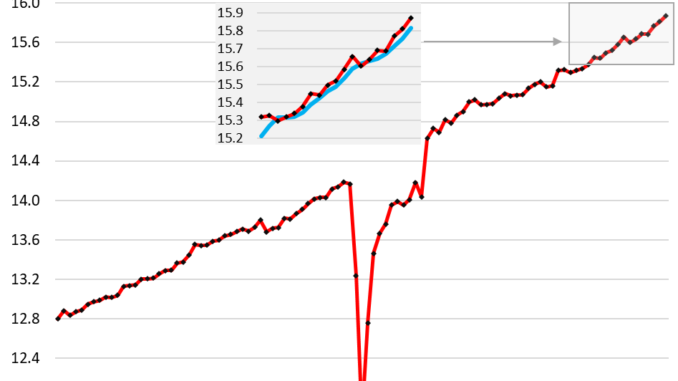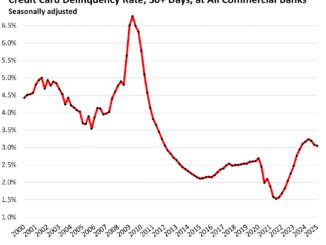
Inflation-adjusted consumer spending jumped. They splurged on durable goods. And still saved some. In response, the Atlanta Fed’s GDPNow jumped.
By Wolf Richter for WOLF STREET.
Consumer spending, adjusted for inflation, rose by 0.39% in July from June. Spending growth in May and June had also been strong, and the three-month average growth also jumped by 0.39%, the highest growth since February 2023, and the second highest since November 2021, according to data from the Bureau of Economic Analysis today. On an annualized basis, that pace of growth over the past three months, adjusted for inflation, was 4.8%!
Year-over-year and adjusted for inflation, consumer spending rose by 2.7%, similar as in May and June. All three months had been the largest year-over-year growth rates since November 2023, and before then since February 2022. (In the chart below, the insert shows the three-month average in blue).
What was particularly fascinating was the inflation-adjusted surge in spending on durable goods over the past three months, where a slowdown had taken place earlier in the year. But starting in May, our Drunken Sailors, as we’ve come to call them lovingly and facetiously, returned to the punch bowl.
Upon the release of this data, the Atlanta Fed’s GDPNow, which attempts to estimate Q3 growth of real GDP, jumped to 2.5% growth, up from 2.0%. The 10-year average real GDP growth for the US is about 2.0%.
Spending on durable goods, adjusted for inflation, jumped by 1.7% in July from June. Given the big monthly squiggles in this metric, we look at its three-month average, which jumped by 1.3% in July. That’s an annualized growth rate of 16.8%!
You can see the slowdown in spending earlier this year through April, and then over the past three months, the return to the punchbowl.
In 2021, we expected that spending would eventually revert to prepandemic trend (blue line), and it tried for a little while, but then just stayed well above it. At this point, it seems to be permanently above the old trend, possibly establishing a new trend line. This kind of shift in demand from trend is just amazing:
Spending on nondurable goods, adjusted for inflation, rose by 0.24% in July from June. The three-month average rose by 0.36%, or about 4.4% annualized, the highest growth rate since February 2023, and beyond that, the highest growth rate since October 2021. Year-over-year, spending rose by 1.8% adjusted for inflation.
Spending on these items, adjusted for inflation, has also not returned to prepandemic trend. Nondurable goods are dominated by food, gasoline, apparel, footwear, household supplies, etc.:
Spending on services, adjusted for inflation, rose by 0.20% for the month (2.4% annualized) and by 2.9% year-over-year.
Spending on services accounts for 65.5% of total consumer spending. It includes rents, utilities, insurance, streaming, broadband, cellphone services, entertainment, healthcare, airfares, lodging, rental cars, memberships, etc.
Spending on services still hasn’t quite reverted to prepandemic trend but is now getting close to it.
Where did our Drunken Sailors get this money?
Personal income without transfer receipts – income from wages, salaries, interest, dividends, rental properties, farm income, small-business income, etc., but excluding Social Security and other transfer payments – and adjusted for inflation, rose by 0.16% in July from June. The three-month average rose by 0.22%. Year-over-year, it grew by 1.7%. This is by how much our Drunken Sailors out-earned inflation.
But during the inflation surge in 2021 through mid-2022, inflation outran wage increases. It took consumers until April 2023 to catch back up with what they’d lost to inflation through mid-2022.
This income growth is a function of employment growth, rising wages, higher dividend and interest incomes, higher rental incomes, etc. About 11 million single-family rental houses are owned by mom-and-pop landlords with 1-9 rentals.
Transfer receipts are dominated by Social Security benefits that grow with more retirees receiving them, and with rising benefits that are adjusted to inflation. Transfer payments also include VA benefits, unemployment benefits, welfare benefits, etc.
During the pandemic, transfer payments were dominated by stimulus checks, unemployment benefits, extra unemployment benefits, and other pandemic payments made to consumers.
This chart shows both personal income without transfer receipts (red) and transfer receipts (blue).
Disposable income, adjusted for inflation, grew 0.11% in July from June. The three-month average grew by 0.17%.
Year-over-year, disposable income after inflation grew by 1.1%, marking the 19th month in a row when disposable income outran inflation on a year-over-year basis, after having taken a hit from early 2021 through mid-2022, when the explosion of inflation overpowered wage increases.
Disposable income is income from all sources minus income taxes and social insurance payments. It’s what consumers have left to spend on goods and services and to save.
And people still spent less than they earned, and they added the remainder to their savings, but they did so at a slower rate.
The savings rate dipped to 2.9%, so they’re adding to their savings at the slowest pace since June 2022.
This is the portion of their disposable income that they didn’t spend. It doesn’t mean that they put it into savings accounts. They might have bought stocks, CDs, or money market funds with it, or left it in their checking account, or used it to pay down credit cards, or whatever.
The surge in home prices (65% of households are homeowners), stock prices, and other assets have caused many Americans to feel confident enough to spend a little more and save a little less. And yet, they’re still adding to their savings.
Take the Survey at https://survey.energynewsbeat.com/




